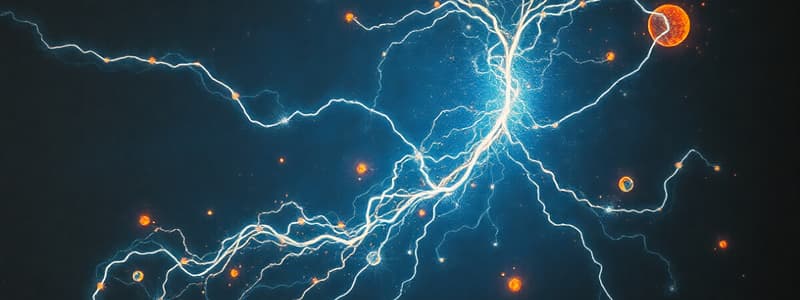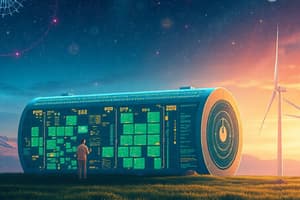Podcast
Questions and Answers
Where do the electrons and the energy to flow in a circuit come from?
Where do the electrons and the energy to flow in a circuit come from?
A chemical reaction occurs inside the battery.
The chemical potential energy of the battery is converted to _____ energy.
The chemical potential energy of the battery is converted to _____ energy.
electrical
Electrons leave the battery at the positive pole.
Electrons leave the battery at the positive pole.
False (B)
What energy allows the electrons to move along the wire?
What energy allows the electrons to move along the wire?
What direction is known as the electron flow?
What direction is known as the electron flow?
What component provides energy for the flow of charge in a circuit?
What component provides energy for the flow of charge in a circuit?
What does a switch do in a circuit?
What does a switch do in a circuit?
A _____ is a component that resists the flow of current in a circuit.
A _____ is a component that resists the flow of current in a circuit.
Which of the following components is a type of resistor that glows?
Which of the following components is a type of resistor that glows?
Where do the electrons and the energy to flow in a circuit come from?
Where do the electrons and the energy to flow in a circuit come from?
What type of energy is converted from the battery for electron movement?
What type of energy is converted from the battery for electron movement?
What does a closed circuit provide for the flow of electrons?
What does a closed circuit provide for the flow of electrons?
Electrons leave the battery at the positive pole.
Electrons leave the battery at the positive pole.
What is the conventional current flow?
What is the conventional current flow?
Which of the following components can be connected in a circuit? (Select all that apply)
Which of the following components can be connected in a circuit? (Select all that apply)
What is the purpose of a resistor in a circuit?
What is the purpose of a resistor in a circuit?
Flashcards are hidden until you start studying
Study Notes
### Battery Energy
- A chemical reaction inside a battery provides energy to electrons in the wire.
- Chemical potential energy is transformed into electrical energy.
- Electrons in the metal wire require kinetic energy to move.
- The battery provides constant energy to ensure continuous electron flow.
- The flow of electrons is called electrical current.
- Energy conversion: chemical energy → electrical energy → kinetic energy
Electron Flow
- Electrons leave the battery from the negative pole and flow towards the positive pole.
- This is known as electron flow.
- Previously, people thought electric current was caused by positive particles moving from the positive pole to the negative pole.
- This is known as conventional current flow.
Circuit Components
- Cells/Batteries: provide energy for electron flow.
- Conducting wires: made of metal (copper) or optic fibre (non-metal).
- Switches: control current flow by opening or closing the circuit.
- Resistors: resist current flow and influence the amount of charge flowing.
- Light bulbs: a type of resistor with a filament that glows.
Battery
- Chemical reactions within a battery provide energy to electrons in the metal wire.
- Battery converts chemical potential energy into electrical energy.
- The battery provides constant energy to the electrons for continuous flow, resulting in a constant electrical current.
- Chemical energy is converted into electrical energy, then into kinetic energy within the circuit.
Electron Flow
- Electrons leave the battery at the negative pole and flow through the circuit towards the positive pole.
- This direction is known as electron flow.
Conventional Current Flow
- Older theories suggested that an electric current was caused by positive particles moving from the positive pole of the battery through the circuit towards the negative pole.
- This direction is called conventional current flow and is still used in some older textbooks.
Components
- A cell (singular) or battery (multiple cells) supplies energy for electron flow.
- Conducting wires, typically copper or optic fiber, transmit the current.
- Switches control the flow of current by opening or closing the circuit.
- Resistors hinder the flow of current, influencing the amount of charge or current strength.
- Light bulbs are a type of resistor where the filament glows, representing the resistance part.
Studying That Suits You
Use AI to generate personalized quizzes and flashcards to suit your learning preferences.



